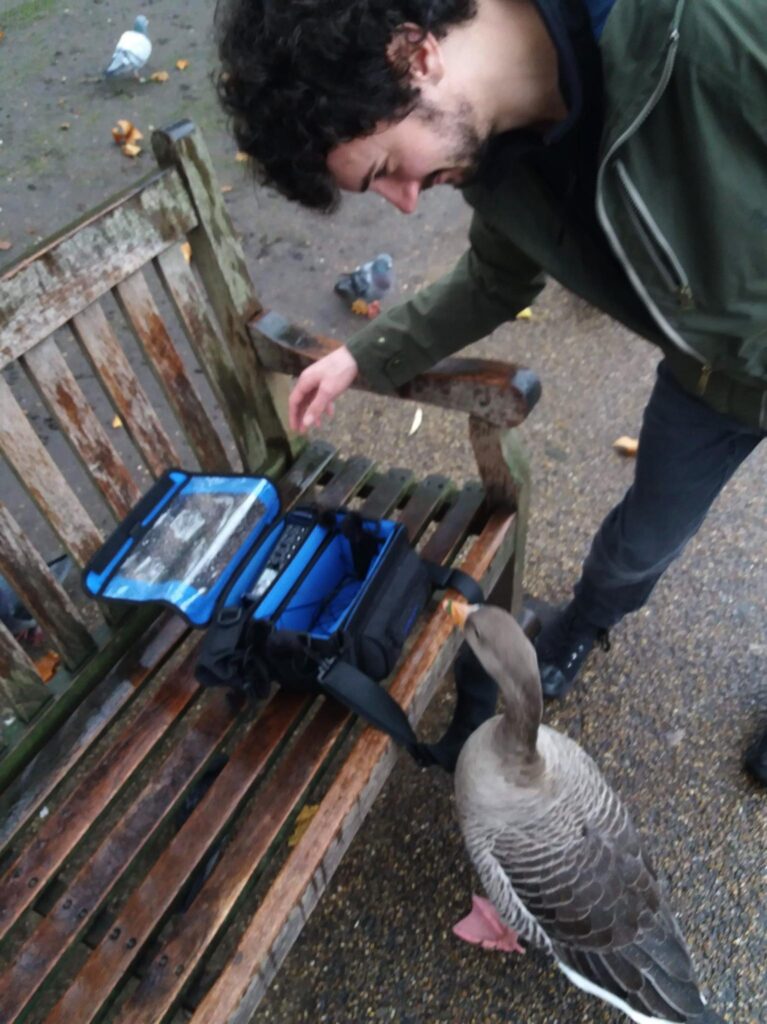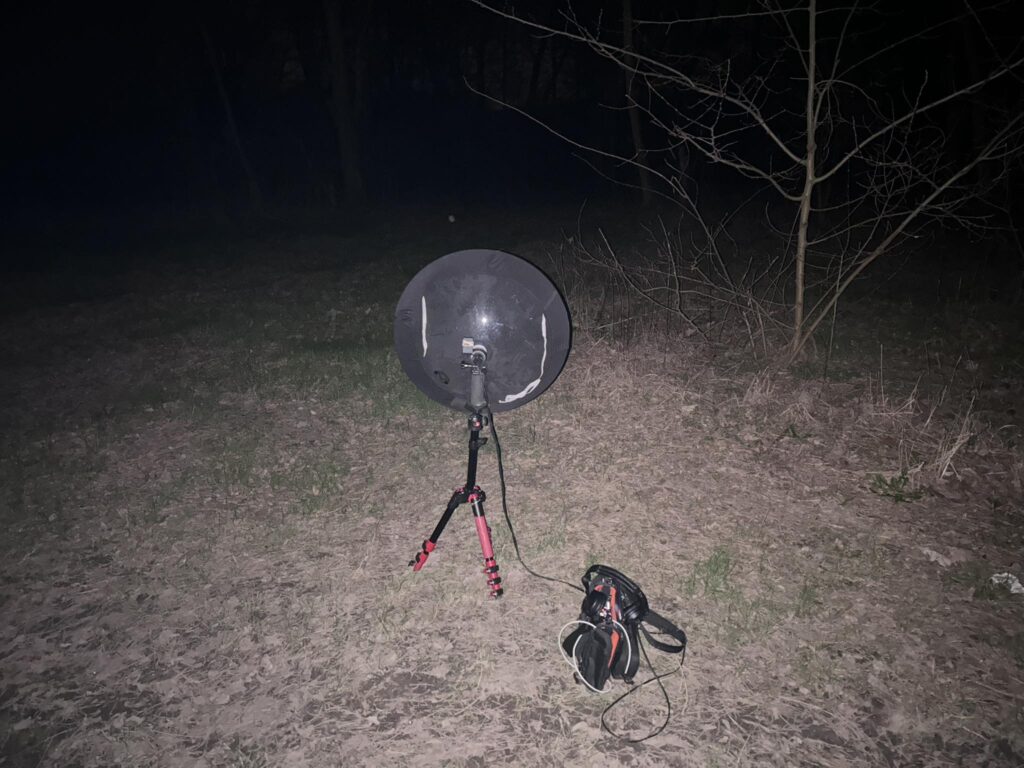PHIL MILL
Reading Time: 7 minutesToday we have the pleasure of having Phil Mill, a young nature recordist that I got to know through the net. I like the enthusiasm he puts into his passion, also interacting on social media. I thank him for his willingness to share with us!

Originally, I’m from the UK at the ripe old age of 33. I have been recording the natural world casually/semi-professionally for around 10 years. This includes everything from natural events to wildlife and different habitats throughout Europe.
Since graduating in London and transitioning from general field recordings to more focused wildlife sound, I’ve been using recording technology and various microphones with the goal of getting closer to nature and capturing more detailed soundscapes.
So far, recording has been more of a personal endeavour than a professional one, serving as a constant way to learn about the natural world we live in. I try to combine this with elements of wildlife tracking and ecology to gain a better understanding of the environments in which wildlife live and how sound can complement that understanding. You can listen to examples of my recordings on [SoundCloud](https://soundcloud.com/phil-mill1) and [Bandcamp](https://philmill.bandcamp.com/).
I have worked in the AV and IT industries, mostly within education and the public sector while living in London, but now I work independently, focusing on sound recording and wildlife—particularly in mountainous regions and the surrounding terrain.
How It All Began:
I started around 2014, and my earliest published recording online was on Radio Aporee. I first became interested in sampling and experimental music during my music studies in my hometown of Colchester. This interest grew from playing in improvised music groups at university. During my degree, I became drawn to ambient music and wanted to incorporate natural soundscapes or found sounds into my work. Moving away from improvised music, I gradually shifted toward making purely field recordings. This transition was prompted in part by learning about Acoustic Ecology from a friend, Martin, who lent me a book by Murray Schafer—a major step in learning how to listen deeply.
During my master’s degree, I discovered the work of Chris Watson and Francisco Lopez, along with many other field recording artists from the US, Europe, and beyond. I devoured as much of their work as I could, and from there, my obsession with exploring the natural world grew.
Although I read many books about wildlife and tried to identify species myself, it wasn’t until I joined the UK Wildlife Sound Recording Society and attended workshops with Chris Watson that I really began to refine the direction I wanted to take. I am no longer really working musically as in formal compositional structures, but sometimes for fun I experiment with ambient music at home, I recently bought a blofeld synth, having wanted one for years. I really like the music of Biosphere and it has inspired me also in both field recording and some more compositional work.
My First Equipment:
When I first started, I bought a Zoom H4n and a Rode shotgun microphone, and using them together completely changed my perspective. As a student, I experimented with DIY methods, building my own hydrophones and contact microphones, and assembling omnidirectional microphones from kits available at Micbooster in the UK.
Initially, I opted to buy or make things myself, largely for affordability reasons. However, the more time I spent recording, the less I wanted to focus on making equipment. Luckily, I discovered LOM and other microphone manufacturers, and I’m still proudly using their gear today.
My First Recordings:
My first recordings were made mostly in my parents’ garden, which I still enjoy recording today. It might sound cliché, but I believe it says a lot about our connection to the natural environments we grow up in. In my parents’ garden in Colchester, there was—and still is—plenty to record. Starlings, House Sparrows, Blackbirds, and Blue Tits regularly dominate the soundscape.
Growing up, I remember the sound of Muntjac deer that used to live on the military base, as well as the calls of foxes throughout the year. I’m really happy I documented these soundscapes as a way to preserve memories of these environments, especially as I was also studying in London at the time.
Current Equipment:
– Sony PCM-D100
– Zoom F1
– USI Pro
– Mikro-usi
– Sound Devices Mixpre6
– Reynolds Ambisonic Microphone
– Zoom H6
– Sennheiser MKH416
– Rode NTG5 Shotgun
– Rode NT1A
– Aquarian Audio Hydrophone (H2a)
– JRF contact mic
– Sound Devices Preamp
– Parabolic reflector (made by Marco Pesente – naturesound.it)
– Ambient ASF-2 hydrophone
– Various Rycote blimps
Radio and Soundscapes:
As my practice developed, and after gaining some experience in radio production, I became interested in creating radio collages of field recordings and wildlife sounds. Post-pandemic, I created a series called *Tracks and Traces* (perhaps poorly named), where I focused on capturing wildlife in various locations—nature reserves, forests, and mountains—over extended periods. Some pieces were species-specific (for example, focusing only on Red Deer). This approach made capturing natural sounds more challenging, as I was striving to represent the best possible wildlife and soundscapes.
Soundscapes have become a valuable way for me to connect with and remember places. Looking back through my archive, I can reflect on how these places have changed—not just in terms of wildlife sounds, but also in their appearance and atmosphere.
Recent Recordings and Projects:
Since the pandemic, I’ve been particularly interested in recording at a badger sett, which offered me plenty of opportunities to capture their sounds—everything from rustling and foraging to all sorts of fascinating vocalisations.
More recently, I’ve been focusing on different bird species, creating a narrative that spans a full year of bird songs and calls. This is available as a playlist on SoundCloud for now, but I might release a few favourites on Bandcamp once the year ends. This current project, centred around bird song, was inspired by the book *A Year in Bird Song: 52 Stories of Songbirds*. You can listen to the playlist on my SoundCloud, and I plan to release it on Bandcamp in January 2025, possibly on other platforms as well.
Favourite Equipment:
Perhaps at sounding cliche, but in terms of recording my favourite tool of all is the ears – sometimes I don’t bother taking headphones with me to the field at all. Also I think working with nature also requires a strong field knowledge, and understanding animal behaviour, wildlife tracking and field signs is a tool for me that has paid off many times in identifying recording spots and often yields good results. From a more technological aspect, in the past year a tool I have enjoyed using a lot is the parabolic microphone made by the owner of this site (Marco). It has been extremely useful in many situations and has changed the way I record in some way. This combined with the Zoom F1 recorder – they make a great combination for me.

I was a bit sceptical about 32bit recorders at first and I don’t always like to use it, but in some situations it has also proven useful when a surprise event arises or for example leaving the parabolic running overnight. For a long time I also used the Sony PCM-D100, but I haven’t used this so much in the past year. I don’t have a real definition, I go to my favourite for every case and often it’s reactive to the environment I’m in or the subject I want to record.
In terms of more professional work instead of just for myself I use the Sound Devices mix pre recorders in all cases, mostly for flexibility and how it’s fairly customisable to different microphones inputs and outputs – as well as its preamps!
Ambisonics is a great tool for recording nature, and many, who use this method much better than me can vouch for that. I used it mostly recently during the rutting season as the deer were roaring from all different places where I had the microphone, and I was on the hillside so it could record them from behind, as well at different angles above and below the mic and could create a more realistic perspective – also without missing something important. Acoustics and reflections of sound are very important during the Rutt and having this tool for capturing all of that is extremely useful.
________________________________________________________________________________________________
In August, summer 2024 I began my search for wolf species around myself. On 2 separate occasions over the years following the pandemic I have found wolf scat, probably one around 2022, the other in 2024. This was left right in the middle of a trail leading up into the mountain; and this sparked an obsession with finding wolves. I started searching, firstly for their den I was checking behind fallen trees and in and around large rock formations. This was a bit fruitless, I then took on other projects and this fell by the wayside. My plan was to return to this later in January, I started recording again in December 2024 making my first attempts at tracking and long-form recordings in the mountains, about 4km away from where I first found the scat. The reason for this was I had discovered freshly made wolf tracks – which I began to follow. The conditions for walking were very challenging, the wolves seemed to move through the snow with ease. Every step I made I sunk deeper than their footprints. I thought to change my approach; and try to find a spot where they most likely visit. I was going everyday for 2 weeks and started to identify patterns, every 6 days they’d return to one location, and on one occasion, the exact same trail, 2 weeks apart – passing the exact same trees, bushes and shrubs. On this occasion I found hair and fresh scat, which I collected for research purposes. I decided that this was the best spot. I placed my mics – the SASS made by Marco on a tree stump, with a very large battery; and a 128gb SD Card. It was enough to last 4 days. Originally I was met by high winds and poor weather conditions, and their howling was pretty much non-existent. Some articles online have shown that they do not move around much in snowfall and poor weather conditions, so I continued trying. One day was perfect, almost no wind, not much snow – and my plan pulled through. The wolves returned, followed the exact same trail, and stopped, right by my microphone. On 2 separate days, a couple days apart they howled here. I think this was an RV point, right in the middle of their territory. It was a great moment to finally hear them – the SASS mic made by Marco was perfect for this recording. Great stereo image, also small and easy to hide, as well as durable – it really with stood all the high winds, snowfall and being buried on a few occasions under feet of snow.

Commenti recenti